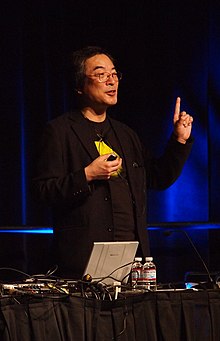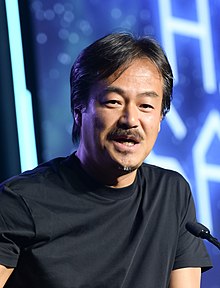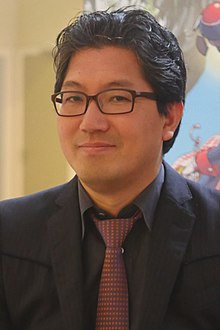Portal:Video games
The Video Games Portal

A video game, also known as a computer game or just a game, is an electronic game that involves interaction with a user interface or input device (such as a joystick, controller, keyboard, or motion sensing device) to generate visual feedback from a display device, most commonly shown in a video format on a television set, computer monitor, flat-panel display or touchscreen on handheld devices, or a virtual reality headset. Most modern video games are audiovisual, with audio complement delivered through speakers or headphones, and sometimes also with other types of sensory feedback (e.g., haptic technology that provides tactile sensations). Some video games also allow microphone and webcam inputs for in-game chatting and livestreaming.
Video games are typically categorized according to their hardware platform, which traditionally includes arcade video games, console games, and computer (PC) games; the latter also encompasses LAN games, online games, and browser games. More recently, the video game industry has expanded onto mobile gaming through mobile devices (such as smartphones and tablet computers), virtual and augmented reality systems, and remote cloud gaming. Video games are also classified into a wide range of genres based on their style of gameplay and target audience. (Full article...)
Featured articles –
Although the game's development appeared to be proceeding towards completion without difficulty, LucasArts abruptly canceled production of Freelance Police in March 2004, citing economic and market conditions. The game's cancellation was received poorly by fans of the series, Steve Purcell, and the video game industry media. Many journalists viewed this move as a culmination in the decline of the adventure game genre. LucasArts later terminated its adventure game development, and many of the Freelance Police design team left to create Telltale Games and continue development of such adventure games. Steve Purcell moved the Sam & Max franchise to Telltale Games in 2005, prompting a revival of Sam & Max video games. (Full article...)
Desmond Daniel Amofah (May 12, 1990 – c. June 19, 2019), known online as Etika, was an American YouTuber and live streamer. Amofah became known online for his enthusiastic reactions to Super Smash Bros. character trailers and Nintendo Direct presentations and for playing and reacting to various games. He resided in the Brooklyn borough of New York City, and his father is the Ghanaian politician Owuraku Amofah.
Starting his online career in 2007, Amofah created his main YouTube channel, "EWNetwork" (Etika World Network), in 2012. His fanbase was dubbed the "JOYCONBOYZ" in reference to the Nintendo Switch controller, the Joy-Con. He garnered popularity following the release of Super Smash Bros. 4, primarily stemming from his reaction videos of news surrounding the game. His content consisted of playthroughs of various video games, reaction videos, and pre-recorded material. Across his multiple YouTube channels, he amassed over 1 million subscribers and 146 million views.
Between October 2018 and May 2019, Amofah demonstrated signs of mental distress, threatening to commit suicide on multiple occasions, and was hospitalized several times. During this period, Amofah uploaded pornography to the EWNetwork channel, resulting in its termination; he then posted statements on social media alluding to suicide. After apologizing, Amofah created another channel, "EtikaFRFX", which was terminated for identical reasons. He proceeded to display erratic behavior publicly, including posting cryptic messages online and streaming himself being detained by the police. (Full article...)
Set in the fictional Pacific City, the player controls a biologically enhanced Agent, tasked with defeating three crime lords and their organized crime syndicates. The Agent's abilities improve by defeating both crime lords and their top subordinates, as well as by completing optional activities, such as street races and scavenger hunts. The gameplay is nonlinear: instead of following a rigid mission sequence, players are free to select the approach to completing their missions and activities. The game features a two-player cooperative play mode via Xbox Live. It was released worldwide in February 2007.
Crackdown, initially planned for release on the original Xbox console, was envisioned as a vast world in which players could experiment and explore freely. Microsoft Game Studios bundled specifically marked copies of Crackdown with an access code to the multiplayer test version of the much-anticipated Halo 3 Beta. The game sold 1.5 million copies in its first six months of release. It received critical acclaim from reviewers and is widely considered to be the best entry in the series. It has garnered several awards for its innovative gameplay. A sequel, Crackdown 2, was released in July 2010 by Ruffian Games without Jones' input, and Crackdown 3 was released for the Xbox One and Microsoft Windows in February 2019, initially to be again directed by Jones before he left to join Epic Games. (Full article...)
Dawn of Sorrow continues the story of Aria of Sorrow: Dracula has been defeated, with his powers assumed by his reincarnation, Soma Cruz. With the help of his allies, Soma avoids becoming the new dark lord. A cult forms to bring forth a new one by killing Soma. Soma and his allies move to ensure that does not happen.
Dawn of Sorrow incorporates many features from earlier Castlevania games: the combination of elements from platform games and role-playing video games, the "Tactical Soul" system featured in Aria of Sorrow and a dark, gothic atmosphere. Dawn of Sorrow introduces gameplay elements, like the "Magic Seal" system, which requires the use of the DS stylus to draw a pattern to defeat powerful enemies, a distinctive anime character design, and a multiplayer mode, where two players compete for fastest times on a prerendered level. The game received high scores from many video game publications, and was considered one of the best games on the Nintendo DS for 2005. The game was re-released in Japan in June 2006, and later in North America during 2007 as part of the "Konami the Best" line. (Full article...)

The Menacer is a light gun peripheral released by Sega in 1992 for its Sega Genesis and Sega CD video game consoles. It was created in response to Nintendo's Super Scope and as Sega's successor to the Master System Light Phaser. The gun is built from three detachable parts (pistol, shoulder stock, sights), and communicates with the television via an infrared sensor. The Menacer was announced at the May 1992 Consumer Electronics Show in Chicago and was released later that year. The gun was bundled with a pack-in six-game cartridge of mostly shooting gallery games. Sega also released a Menacer bundle with Terminator 2: The Arcade Game.
Sega producer Mac Senour was responsible for the Menacer project and designed the six-game pack. He originally proposed non-shooting minigames based on existing Sega licenses like Joe Montana, David Robinson, and ToeJam & Earl, but most of the prototypes were abandoned due to high cost in favor of more shooting-type games. Sega did not plan another first-party release for the Menacer apart from the included multicart. Compatible games were published through 1995.
The Menacer is remembered as a critical and commercial flop. Critics found the six-game pack subpar and repetitive, and criticized the peripheral's lack of games. The ToeJam & Earl spinoff game was held in the highest regard, and reviewers recommended the Menacer-compatible Terminator 2 game. A direct-to-TV light gun that includes the six-game Menacer pack was released in 2005. (Full article...)
Customer surveys from Stainless Steel's previous game, Empire Earth, were used as a starting point for Empires: these inspired the team to take a more minimalist design approach, and to include civilizations without overlapping styles of play. Development was led by designer Rick Goodman who felt that historical realism often constrained gameplay rather than be a source of inspiration.
Empires was positively received by critics, who enjoyed its multiplayer component. However, certain reviewers disliked its single-player mode, and opinion clashed on the game's level of uniqueness compared to competitors such as Rise of Nations. The sales of Empires, when combined with those of Empire Earth, totaled 2.5 million units by 2004. (Full article...)
Set in a retro-futuristic version of 1988, the story follows a ninja named Ryu Hayabusa as he journeys to America to avenge his murdered father. There, he learns that a person named "the Jaquio" plans to take control of the world by unleashing an ancient demon through the power contained in two statues. Featuring side-scrolling platform gameplay similar to Castlevania, players control Ryu through six "Acts" that comprise 20 levels; they encounter enemies that must be dispatched with Ryu's katana and other secondary weapons.
Ninja Gaiden has an elaborate story told through anime-like cinematic cutscenes. It received extensive coverage and won several awards from video gaming magazines, while criticism focused on its high difficulty, particularly in the later levels. Director Hideo Yoshizawa named Ninja Gaiden as his most commercially successful project. The game continued to receive acclaim from print and online publications, being cited as one of the greatest video games of all time. It was novelized as part of the Worlds of Power game adaptations written by Seth Godin and Peter Lerangis. The game was followed by Ninja Gaiden II: The Dark Sword of Chaos (1990) and Ninja Gaiden III: The Ancient Ship of Doom (1991). A manga-styled comic book, Ninja Gaiden '88, published by Dark Horse Comics, continued the narrative of the five original games. (Full article...)
The name Alleyway references the in-game gateway that the player's spaceship (represented as a paddle) must pass through. While Alleyway is a portable clone of Breakout, it adds several features, including alternating stages, bonus rounds, and hazards for the player at later levels. While the game's original box art featured an unidentifiable protagonist, later international releases of the game replaced the character with Mario. Alleyway was released with limited advertising, receiving moderate to low scores from reviewers who compared it to games like Arkanoid. (Full article...)
Did you know... -
- ... that the 1999 video game Interplay Sports Baseball Edition 2000 used a public-address announcer while its rivals were switching to two commentators as featured on real MLB game broadcasts?
- ... that the name of the video game mod series Bomba Patch was inspired by éclairs?
- ... that the web-based video game Moderator Mayhem was based on a card game meant to demonstrate the difficulties of content moderation?
- ... that the 1979 video game Superman was one of the first console games with a pause feature?
- ... that Rockstar Vienna was the largest video game developer in Austria when it closed in 2006?
- ... that Elena from the video game series Street Fighter uses a capoeira fighting style, for which the development team used travel videos as reference material as they had no experience with the style?
- ... that the contrabass trombone has experienced a revival in film music and video game soundtracks?
- ... that the album series Jingle Cats spawned Jingle Dogs, Jingle Babies, and a Japanese video game in which "the object is to breed and care for cats, which begin to sing when they're done copulating"?
- ... that for at least 90 minutes, Mori Calliope livestreamed herself begging video game developer Atlus to allow her to stream their game Persona 3?
- ... that the leak of the upcoming Grand Theft Auto game was described as one of the biggest leaks in video game history?
- ... that the robotic enemies in the video game The Incredible Hulk were influenced by Marvel Comics' objection to the Hulk killing humanoid characters?
- ... that MicroProse was formed to publish Hellcat Ace after Sid Meier boasted that he could design a better video game than Red Baron in a week?
Selected biography –
Selected image -

Recent video game-related events
- September 12, 2024 – 2023–2024 video game industry layoffs
- Microsoft announces that it will lay off 650 Microsoft Gaming employees as part of cuts to its workforce. (Variety)
- August 15, 2024 –
- American video game magazine Game Informer discontinues publication after 33 years. The magazine's website is also shut down. (BBC News)
- May 24, 2024 – Uvalde school shooting
- Families in Uvalde, Texas, U.S., file a lawsuit against Daniel Defense and Activision Blizzard for creating the DDM4 V7 gun and promoting the weapon through the game Call of Duty, respectively. They also sue Meta Platforms for owning Instagram, which was used by the gunman. (AP)
Topics
Categories
Things you can do
In other Wikimedia projects
The following Wikimedia Foundation sister projects provide more on this subject:
-
Commons
Free media repository -
Wikibooks
Free textbooks and manuals -
Wikidata
Free knowledge base -
Wikinews
Free-content news -
Wikiquote
Collection of quotations -
Wikisource
Free-content library -
Wikiversity
Free learning tools -
Wiktionary
Dictionary and thesaurus















































